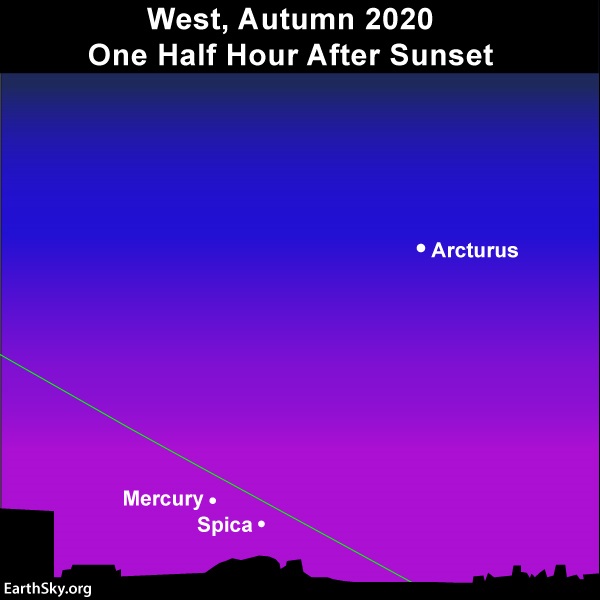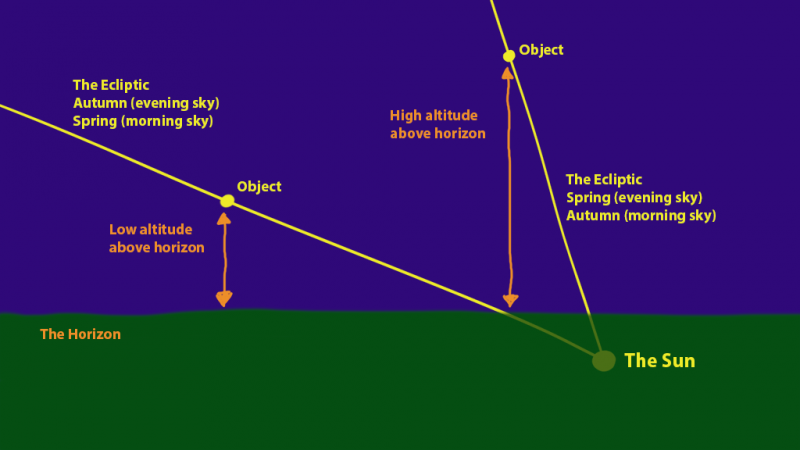
Note that the chart above is a Southern Hemisphere chart. Southern Hemisphere observers have been seeing Mercury already this month, near the star Spica in the constellation Virgo the Maiden. From there, the innermost planet can be seen for more than an hour after sunset in late September 2020, and thus it can be seen in a relatively dark sky.
If you’re in the Northern Hemisphere, you have to look for Mercury much, much sooner after sunset. If you do catch it, it’ll be in a sky still lit with bright twilight (see the chart below). Still, from the Northern Hemisphere, your best chance of seeing Mercury during the current evening apparition begins around late September. The innermost planet is now swinging out to a greatest elongation, or greatest angular distance from the sun on our sky’s dome. Beginning on September 26, 2020, Mercury is over 25 degrees east of the sun, placing it in the western sky after sunset. It will remain at better than 25 degrees east of the sun until October 7, 2020. On October 1, 2020 – on the same date as 2020’s full Harvest Moon for the Northern Hemisphere – Mercury will sweep to its greatest elongation of 25.8 degrees east of the sun.
Why has Mercury been visible to Southern Hemisphere viewers already this month, but not so much for us in the Northern Hemisphere? When a greatest evening elongation of an inferior planet, such as Mercury, closely coincides with the spring equinox, viewers can anticipate on a fine evening apparition of Mercury. Since the recent September equinox counts as the Southern Hemisphere’s spring equinox, the Southern Hemisphere has a favorable evening view of Mercury.
Yet, when a greatest evening elongation of Mercury closely coincides with the autumn equinox, it results in a poor apparition of Mercury in the evening sky. Given that the September equinox is the Northern Hemisphere’s autumn equinox, mid-northern latitudes will have a hard time teasing Mercury out of the afterglow of sunset, even with binoculars, and even when it is farthest from the sun on October 1.
Why good in the Southern Hemisphere and poor in the Northern Hemisphere? It’s because the ecliptic – the pathway of the planets – hits the horizon at its steepest angle for the year at sunset on the spring equinox, yet at its shallowest angle for the year at sunset on the autumn equinox. On our two charts (above and below), by the way, you can see the ecliptic as a green line.
Hence, the Southern Hemisphere enjoys a ringside seat to this present evening apparition of Mercury whereas northerly latitudes must be relegated to the bleachers.

So Mercury sets closer to sunset at more northerly latitudes, but stays out longer after sunset at more southerly latitudes. We give Mercury’s setting time relative to sunset, and the time for nightfall (end of astronomical twilight).
For October 1, 2020:
40 degrees north latitude
Mercury sets 50 minutes (5/6 hour) after sunset
Nightfall: 90 minutes (1 1/2 hours) after sunsetEquator (0 degrees latitude)
Mercury sets 90 minutes (1 1/2 hours) after sunset
Nightfall: 70 minutes (1 1/6 hours) after sunset35 degrees south latitude
Mercury sets over 120 minutes (2 hours) after sunset
Nightfall: 86 minutes (nearly 1 1/2 hours) after sunsetWant more specific info? Click here for a sky almanac
Want to know the time of sunset in your specific location? Try this custom sunrise-sunset calendar.
Want to see a chart showing Mercury for a particular date in your specific location? Try Stellarium.

Strictly speaking, the ecliptic is the Earth’s orbital plane projected onto the constellations of the zodiac. The ecliptic also depicts the sun’s annual eastward path in front of the backdrop stars, as viewed from Earth.
Of course, the sun’s apparent annual motion is really a reflection of Earth’s orbital motion around the sun.
Because the planets orbit the sun on the nearly the same planet that Earth orbits the sun, you’ll always find the planets of the solar system on or near the ecliptic.

Bottom line: If you live in the Southern Hemisphere, take advantage of your golden opportunity to view Mercury in the evening sky in September and early October. If you live in the Northern Hemisphere, give Mercury a try! You might see it.











